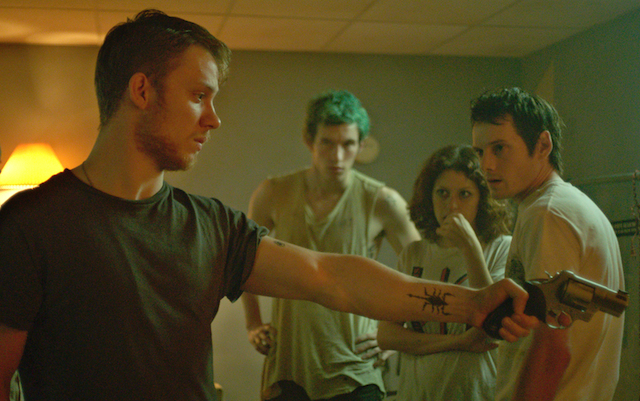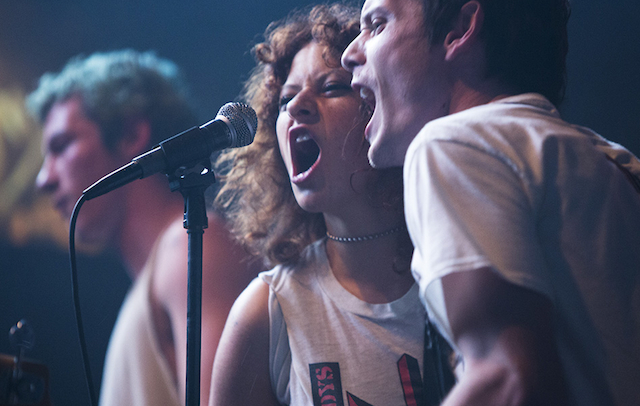CHICAGO – In anticipation of the scariest week of the year, HollywoodChicago.com launches its 2024 Movie Gifts series, which will suggest DVDs and collections for holiday giving.
Interview: Director Jeremy Saulnier Invites Us to ‘Green Room’
CHICAGO – Combining punk rock, neo-Nazism and horror is not an easy balancing act, but filmmaker Jeremy Saulnier (“Blue Ruin”) was up to the task. As a former punker himself, it was natural to transfer the energy of that music, and translate it into a slash and burn scary movie. It’s time to step into the ‘Green Room.’
The film is a gut punch, as a post modern punk band (which includes members portrayed by Imogen Poots and Anton Yelchin) needs a gig so desperately that they are booked into a Nazi skinhead venue. When a situation goes awry in the “Green Room” (the typical backstage waiting area), the band bites off more than they can chew, to put it mildly. One of the surprising elements of the movie is the appearance of Patrick Stewart as Darcy, one of the Nazi facilitators.

Happiness is a Warm Director: Jeremy Saulnier Demonstrates Technique for ‘Green Room’
Photo credit: Broad Green Pictures
Writer/director Jeremy Saulnier first gained attention in 2007, with the release of his debut film “Murder Party.” His acclaim came with his next film, “Blue Ruin” (2013), a film festival darling that was set in suburban America. His background as a punk rock fan informed this third feature film, and HollywoodChicago.com caught up to him in a roundtable interview (the other outlets designated with QUESTION), where he discussed the environment of the film’s origins.
HollywoodChicago.com: In designing the concept of the typical rock club “green room,” what kind of production design did you want for that room, to give it the ambiance of dread that you associated with it?
Jeremy Saulnier: We did a lot of research to find the right references, to make it seem authentic, but it also had to have to serve my needs narratively. We originally designed it to be a little more camera friendly, and it ended up being far too big, it was a great last minute save to confine it. It served the purpose of being in a pressure cooker. Texturally, we had the wood paneling of an older room, covered with graffiti, which gave it diversity and the proper look.
QUESTION: Because the band in the film is punk, was that something you had interest in before or did it just fit into the story?
Saulnier: Punk has been part of my world for decades. I was in the hardcore punk scene in the Virginia/Washington, D.C. area in the early 1990s. Once I got my driver’s license we’d travel to D.C. to see the shows there. It was the birthplace of hardcore, and Nazi skinheads would be every show. It was diverse – there were Vegans, Nazis, Krishnas and guys in letterman jackets. It was a vibrant time, but the key was we had to show up. If you wanted the cassette or record, you had to find it yourself. There was shoe leather and commitment. I was there for the experience.
It was a mission for me, I knew someday I’d make a punk rock movie, because there was so much energy and texture I could mine. And having been so intimately involved, I felt responsible to authentically present this scene in a way I hadn’t seen done before. But I didn’t want to bog the film down in punk rock ideology. It was about ‘this is the world, this is the texture, and we’re here for a reason.’
HollywoodChicago.com: The cult-like attitude of the skinheads in the film contain much of the mystery, as well as why the initial murder had occurred. Does it matter what plans the punk rockers are altering, or is there a larger theme to save us all from, in the way that they mess up everything?
Saulnier: There is a lot going on, and the fun part is it doesn’t really matter. [laughs] – it doesn’t play into the experience or atmosphere. There are lots of different threads, but all the band wants to do is survive. The audience has to fill in the gaps, and that is also fun. The key is the irrelevancy, there are multiple conflicts in play, thus multiple conflicts arise. It is an examination of a clusterf**k, but as long as the perspective is with the band, they could care less what plans they are thwarting.
QUESTION: The violence in your film is not typical. What was your approach to showing violence in the film?
Saulnier: I liked the heightened scenario, and I liked the fact that essentially we had civilians versus soldiers. The violence for me was an awkward and brutal approach, where I was looking for the impact of that violence. It’s the threat of violence that creates tension, not so much the body count. When it happens, I like it to be a little confusing. There were people clapping at some of the screenings, but I think that is because they needed a release, it’s not to celebrate the act.
What I learned with ‘Blue Ruin.’ I had a very intense scene with culminated in a graphic death. I considered it an absolute gut punch, and for the more part the audience would roar – even the French reacted that way! But it was all based on who we saved. I like make up effects and general realism, and any false note in a film takes me out of it. So I wanted to make sure the violence had the intensity it needs to target the involuntary nervous system, and not your brain.

Punks Rock in Writer/Director Jeremy Saulnier’s New Film ‘Green Room’
Photo credit: Broad Green Pictures
HollywoodChicago.com: What do you think is more interesting about a person, and what tells you more about them – the type of music they listen to that makes them cool, or the secret shame of their hidden and less cool musical tastes?
Saulnier No doubt it’s the secret shame, and the hidden tastes. For me, when I was learning how to like punk, I had to buy albums cold. I loved some of it, and I was disappointed other times. Part of the feeling is knowing that you like something, and having the confidence to like what you like, no matter what the genre is. When you become an adult, and cool is no longer the currency, it’s about who people are and if they’re nice to be around and generous, and that’s when those desert island bands are honestly expressed.
QUESTION: What was the background of Patrick Stewart’s involvement in the film and his inspiration to taking on the character?
Saulnier: You’d have to ask Patrick Stewart what his inspiration was to actually do my movie. [laughs] The inspiration for me to cast him was simply he was interested in the role. ‘Hell yes, come on board!’
HollywoodChicago.com: Did he intimidate you at all?
Saulnier: I was bracing for that, but no. I couldn’t be happier with my experience working with him. He was a craftsman, and gave me guidance when I needed it. I also helped him find the character in a short time frame. He flew in the day we shot his finale, so we had to work in reverse order to get the character right, which is tough. On set, all I cared about was having a good and dedicated actor, and he was all that.
HollywoodChicago.com: Has he helped on selling the film?
Saulnier: Yes, it’s so much fun to see him promote the film. He came to the Toronto Film Festival and went to both screenings, and he didn’t have to. He was just hanging around. He actually experienced his first ‘midnight movie’ with us, because generally he doesn’t do these types of films. He had no idea regarding the energy level of these types of crowds, and he was enamored by it. He fell in love with just being in the audience, and hearing people clap, cheer and gasp.
 | By PATRICK McDONALD |


